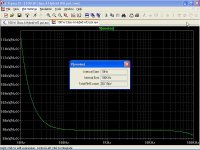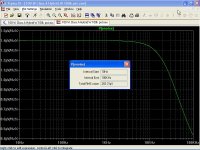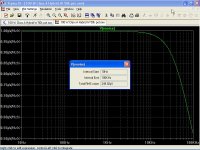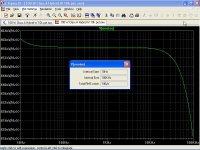I'm still mystified, but I guess that's better than being offended.
I apologize, just in case you are no longer mystified.
Dude, if you are going to theorize on molecules (or make-up chemistry) be aware that Sy is a specialist!
More than that, he is "The Specialist"
"but in general ruffrecords makes a good point.."
Apropos to nothing in the topic, but I've been following RuffRecords work in developing valve-based recording gear and it seems that EVERY point he makes is a good one.
It's not been often in the last 40 years that I've actually enjoyed following someone's development and thought process.
Kevin, I think you (and many other's reading this) would enjoy a visit to his web site.
Apropos to nothing in the topic, but I've been following RuffRecords work in developing valve-based recording gear and it seems that EVERY point he makes is a good one.
It's not been often in the last 40 years that I've actually enjoyed following someone's development and thought process.
Kevin, I think you (and many other's reading this) would enjoy a visit to his web site.
I'm still using 100K stepped attenuators to maintain compatibility with older tube gear, but in general ruffrecords makes a good point.. A 25K or 50K pot or attenuator would be a much better choice wrt input tube miller capacitance provided that all sources contemplated perform adequately into the proposed load impedance that pot or attenuator represents. (What a mouthful..)
Another obvious option is to choose tubes with low Cag and low mu, still a lower resistance pot would probably be a bigger win.
"but in general ruffrecords makes a good point.."
Apropos to nothing in the topic, but I've been following RuffRecords work in developing valve-based recording gear and it seems that EVERY point he makes is a good one.
It's not been often in the last 40 years that I've actually enjoyed following someone's development and thought process.
Kevin, I think you (and many other's reading this) would enjoy a visit to his web site.
Hey DrRick
Put the link, please, I too am interested.
Hey Don,
Me Too!
Also, we never had any hum issues with out DHT's because once a week the horse-drawn storage-battery truck would drop by for a quick cell-exchange!
Me Too!
Also, we never had any hum issues with out DHT's because once a week the horse-drawn storage-battery truck would drop by for a quick cell-exchange!
Humpf. Things were much simpler, back in my day. Volume pots were 500K, and the grid leak resistor was a pencil mark on a piece of bakelite with a screw terminal at each end of the mark.
The link: Yes, please.
Hey Don,
Me Too!
Also, we never had any hum issues with out DHT's because once a week the horse-drawn storage-battery truck would drop by for a quick cell-exchange!
Home delivery? Luxury. We had to take ours down to the local garage (auto mechanic workshop).
How come I can't buy B and C batteries any more? How come there's more hair growing out of my ears than on my head? Why isn't The Bob Hope Show on the radio any more? Time for my Geritol...
Thanks for the link.
"but in general ruffrecords makes a good point.."
Apropos to nothing in the topic, but I've been following RuffRecords work in developing valve-based recording gear and it seems that EVERY point he makes is a good one.
It's not been often in the last 40 years that I've actually enjoyed following someone's development and thought process.
Kevin, I think you (and many other's reading this) would enjoy a visit to his web site.
I don't think I am THAT good but thanks for the kind words nonetheless.
People might also like my DIY site too:
http://www.ianbell.ukfsn.org/EzTubeMixer/
Cheers
Ian
Ian,
I meant to post both. Thanks!
I meant to post both. Thanks!
I don't think I am THAT good but thanks for the kind words nonetheless.
People might also like my DIY site too:
http://www.ianbell.ukfsn.org/EzTubeMixer/
Cheers
Ian
Hi Ian, hi DrRick, thanks for the links ! 
Now try to show that putting a pot on the input of a high gain amplifier, in this case a 100W class A hybrid, is not a very good idea.
Sim#1 - Amp without pot.
Sim#2 - Amp with 100K pot.
Sim#3 - Amp with 50K pot.
Sim#4 - Amp with 10K pot.
Now try to show that putting a pot on the input of a high gain amplifier, in this case a 100W class A hybrid, is not a very good idea.
Sim#1 - Amp without pot.
Sim#2 - Amp with 100K pot.
Sim#3 - Amp with 50K pot.
Sim#4 - Amp with 10K pot.
Attachments
Last edited:
It may surprise you, but I did read the whole thread. While I note there are some 50 posts, a mere handful relate to pots, and not a single one proposes how to control the output volume in the absence of a pot, or a switched attenuator.
Pots, or variable attenuators, are a necessary evil in any practical music reproduction system intended for use in a domestic environment. Many systems moreover, manage to have a pot without any audible noise. Even in those systems where there is audible noise, it is masked by the music in most circumstances, and noise is regarded by many as the most tolerable of flaws in a reproducing system.
So what's your point?
Pots, or variable attenuators, are a necessary evil in any practical music reproduction system intended for use in a domestic environment. Many systems moreover, manage to have a pot without any audible noise. Even in those systems where there is audible noise, it is masked by the music in most circumstances, and noise is regarded by many as the most tolerable of flaws in a reproducing system.
So what's your point?
It may surprise you, but I did read the whole thread.
I can vouch for this.
While I note there are some 50 posts, a mere handful relate to pots, and not a single one proposes how to control the output volume in the absence of a pot, or a switched attenuator.
What you say is correct, there are only a few posts referred specifically to the pot, some joke among friends, and as any exchange of ideas, several interesting issues arise.
Pots, or variable attenuators, are a necessary evil in any practical music reproduction system intended for use in a domestic environment. Many systems moreover, manage to have a pot without any audible noise. Even in those systems where there is audible noise, it is masked by the music in most circumstances, and noise is regarded by many as the most tolerable of flaws in a reproducing system.
In the world of the SS, the pot presents no difficulties, being low impedance devices, you can put very low pot values.
However, with valves, it gets more difficult, and the noise starts to be an issue.
We also discussed the effect on bandwidth and phase shift.
So what's your point?
As you say, the pot is a necessary evil, my point is to put it where do the least damage.
Last edited:
As you say, the pot is a necessary evil, my point is to put it where do the least damage.

It is fairly obvious that a large value pot contributes more noise than a smaller value one. It is also fairly obvious that the noise contribution of a pot will be greater if you put more gain after it. So to answer your question it will create the least noise if it is last in the chain. So what you really need is a 100W constant impedance T pad connected between the 100W amp output and the loudspeakers. This may well affect the damping factor but that is a whole other debate.
What you really need to look at are ALL the noise sources in the system including the source material and compare their values relative to the pot at each proposed placement of the pot.
Something to consider: just about every professional mixer uses 10K faders so just about every source you feed through your pre-amp has been through at least one and probably several 10K pots. If you use a 10K pot at your pre-amp input, how is its noise contribution likely to compare with that of all the 10K pots that preceded it?
Cheers
Ian
It is fairly obvious that a large value pot contributes more noise than a smaller value one. It is also fairly obvious that the noise contribution of a pot will be greater if you put more gain after it.
It is fairly obvious to you, that you know a lot and have all the experience.
Besides my lack of knowledge, I think slowly, and nor with the equations in front of me I could see the problem.
Judging by the countless number of circuits that adopt the traditional scheme, even with 500K pot, probably I am not the only one.
When I noticed the problem, it was a revelation to me ! and I want to share it.
So to answer your question it will create the least noise if it is last in the chain. So what you really need is a 100W constant impedance T pad connected between the 100W amp output and the loudspeakers. This may well affect the damping factor but that is a whole other debate.
I believe that without deep bass, musical experience would be incomplete, and given the not very low output impedance of valve amps, I designed my hybrid.
Anything that reduces damping factor, is not a good deal, especially when you do not use global feedback.
What you really need to look at are ALL the noise sources in the system including the source material and compare their values relative to the pot at each proposed placement of the pot.
That is precisely the idea, but as I said before, we have no control over the source material, for each format, analog or digital, it can vary greatly depending on the recording company, not just blame the recording engineer.
Something to consider: just about every professional mixer uses 10K faders so just about every source you feed through your pre-amp has been through at least one and probably several 10K pots. If you use a 10K pot at your pre-amp input, how is its noise contribution likely to compare with that of all the 10K pots that preceded it?
Cheers
Ian
Good point, but it gives me chills just thinking about it, is not a trivial issue, fortunately I do not need a mixer.
Another approach is to use transformer based attenuators, but the magnetic hysteresis curve is far from a straight line, and the use of exotic materials is far from my pocket.
Pots, or variable attenuators, are a necessary evil in any practical music reproduction system intended for use in a domestic environment.
The new Benchmark DAC2 uses 32 bit internals to keep volume control enitely in the diigtal domain. As they put it, "digital inputs never pass through an analog potentiometer."
It is fairly obvious to you, that you know a lot and have all the experience.
Besides my lack of knowledge, I think slowly, and nor with the equations in front of me I could see the problem.
Judging by the countless number of circuits that adopt the traditional scheme, even with 500K pot, probably I am not the only one.
When I noticed the problem, it was a revelation to me ! and I want to share it.
Fair enough, but I think calling the volume pot a 'villain' is a little premature.
That is precisely the idea, but as I said before, we have no control over the source material, for each format, analog or digital, it can vary greatly depending on the recording company, not just blame the recording engineer.
And the point is there is a whole range of noise sources in the pre-amp that you can control and pot noise is just one of them. You need to examine and quantify the others before you brand the volume pot as the 'villain'.
Cheers
Ian
As you say, the pot is a necessary evil, my point is to put it where do the least damage.

Hmm. Not exactly news to anyone who has ever designed a radio receiver.
Perhaps a brief recap of Friis' noise equation might have got us to the point a little quicker.
The new Benchmark DAC2 uses 32 bit internals to keep volume control enitely in the diigtal domain. As they put it, "digital inputs never pass through an analog potentiometer."
Good point. Not the one the OP was making, I think, but a good point nevertheless. Shame you couldn't have made it at the beginning of the thread, then we might have short-circuited some 50-odd posts...
- Status
- This old topic is closed. If you want to reopen this topic, contact a moderator using the "Report Post" button.
- Home
- Amplifiers
- Tubes / Valves
- The volume pot - The hidden villain of preamp



